what effect does urban development have on flooding compared to rural areas?
Abstract
Urbanization increases regional impervious area, which more often than not reduces hydrologic response time and therefore increases flood risk. The objective of this work is to investigate the sensitivities of urban flooding to urban state growth through simulation of flood flows nether different urbanization weather condition and during unlike flooding stages. A sub-watershed in Toronto, Canada, with urban land conversion was selected as a test site for this study. In order to investigate the furnishings of urbanization on changes in urban flood chance, land use maps from six different years (1966, 1971, 1976, 1981, 1986, and 2000) and of six imitation land utilise scenarios (0%, xx%, 40%, 60, eighty%, and 100% impervious surface expanse percentages) were input into coupled hydrologic and hydraulic models. The results show that urbanization creates college surface runoff and river discharge rates and shortened times to achieve the peak runoff and discharge. Areas influenced by flash flood and floodplain increases due to urbanization are related not only to overall impervious expanse percentage only also to the spatial distribution of impervious surface coverage. With similar boilerplate impervious surface surface area percentage, land use with spatial variation may aggravate flash inundation conditions more than intensely compared to spatially compatible land utilize distribution.
Introduction
During urbanization, rain water motion and storage at ground surface within a local watershed are significantly altered by the changes in landscape from natural to man-made (Berth 1991). Paved impervious Footnote 1 materials block water from natural penetration, decreasing the surface infiltration charge per unit. When the atmospheric precipitation rate is college than the infiltration maximum rate, excess precipitation volition motility apace as overland period toward a stream channel and contribute to short-term stream response, leading potentially to soil erosion and flooding (Dingman 2015). To assess urbanization touch on inundation risk, ii common information sources are historical records and flood modeling results. Early studies chronicle urbanization to the magnitude and frequency of urban flooding through historical field measurements from river gauges and rainfall gauging stations (Anderson 1970; Espey et al. 1966; Hollis 1974; Kinosita and Sonda 1971; Martens 1966; Hollis 1975; Moscrip and Montgomery 1997). More than recently, advanced nonstationary flood-frequency models have been used to bear witness that urbanization has statistically significant effect on the growing magnitude and frequency of floods (Villarini et al. 2009; Prosdocimi et al. 2015). Thanks to the rapid development in computation power, application of complicated flood models has become feasible. Bronstert et al. (2007) used a multi-scale, process-oriented coupling difference model to simulate flood belch in catchments at dissimilar urbanization stages and formulated a serial relations between the country employ and flood peak discharges under dissimilar storm scenarios. In Banasik and Pham'southward study, flood hydrographs under 2 historical land utilize conditions in different years and one hypothetical land use status were simulated using a rainfall-runoff model for a small watershed (Banasik and Pham 2010). Also using rainfall-runoff models, flood peak discharges under historical land use conditions in different years were modeled and were institute to exhibit large increases in summit belch due to urbanization (Al-Ghamdi et al. 2012; Zhao et al. 2016). Yin et al. (2015) proposed a novel scenario-based framework where numerical modeling was undertaken to quantify flood risks using 3 anthropogenic variables (land subsidence, urbanization, and inundation defence force). Huang, et al. (Huang et al. 2017) faux overflowing expanse and average depth for state utilise conditions in three unlike years in fluvial inundation scenarios with a hydraulic model (Yu and Lane 2006a, b). Equally the main source for land use information, remote sensing images collected by different sensors were evaluated for overflowing modeling (Verbeiren et al. 2013; Berezowski et al. 2012).
All the same, the current overland catamenia models for urban flood simulation tend to simplify the watershed under study by bold a uniform hydraulic roughness value Footnote 2 (eastward.chiliad., Manning'south n-value) (Water 2010; Rossman 2010). Our research aims to address this information gap past providing 2D overland flow patterns at different urbanization stages using distributed land utilise maps to account for spatially variable hydraulic roughness values. To account for these urbanization stages, land employ maps from six unlike years (1966, 1971, 1976, 1981, 1986, and 2000), hereafter referred to equally Case A, and six imitation land apply scenarios (0%, 20%, 40%, 60, 80%, and 100% ISA percentages), hereafter referred to as Case B, have been input sequentially into i hydrologic and ane hydraulic model. The ii software packages, the hydrologic software Hydrologic Engineering Centre–Hydrological Model System (HEC-HMS) and the hydraulic software Hydrologic Engineering science Center-River Assay System (HEC-RAS), were coupled in this study. These packages were developed at the Usa Army Corps of Engineers Hydrologic Technology Eye (HEC) and were chosen for our research because of their high performance and ease of access (Khaghan and Mojaradi 2016; Hashemyan et al. 2015). During an intense rainfall, the limited capacity of urban drainage systems is bereft to prevent pluvial flooding from taking on the form of a flash flood. As a consequence, fast convergence of overland flow and man-fabricated drainage system outlet flow to nearby rivers trigger fluvial flooding (Chen et al. 2010; Patra et al. 2016). The combined damage of pluvial and fluvial flooding during an intense rainfall may greatly exceed their private consequences (Chen et al. 2010; Apel et al. 2016). In most cases, a multi-source urban flooding consequence is simply classified into one category. Our research involves analyzing both pluvial and fluvial flooding during a atmospheric precipitation upshot with 2 different hydrologic/hydraulic modeling strategies.
Study area and information preparation
Study area
The Don Valley watershed, located in the Greater Toronto Area (GTA) of Ontario, Canada, was used equally the study expanse for software prototyping and application. The lower role of the watershed is in urban center of Toronto boundary, an area with a long history of damaging urban floods (Armenakis and Nirupama 2014). Although the Toronto municipal government has put groovy effort into improving its infrastructure from an engineering infrastructure perspective (Kellershohn 2016), flash flooding remains a dangerous and costly hazard that needs to be improve understood using adept predictive tools. The Don Valley watershed occupies an surface area of approximately 367 km2. Equally a highly urbanized and low-lying watershed in Toronto, the Don Valley watershed readily floods fifty-fifty under relatively minor rainfall events (Nirupama et al. 2014) (Fig. 1).
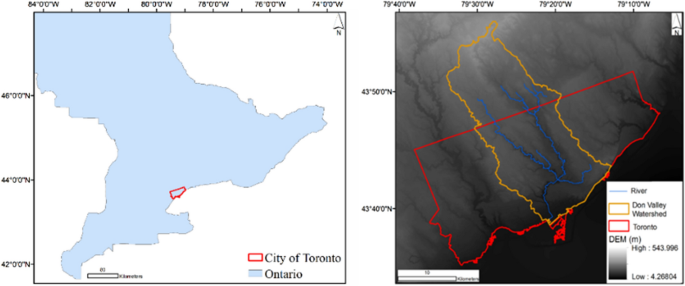
The geolocation of the study surface area, Don Valley watershed (left: location of urban center of Toronto, right: written report watershed)
Data
For GTA, rich national and provincial information are available from GeoBase Footnote three (Natural Resources Canada), Scholars GeoPortal Footnote iv (Ontario Quango of University Libraries), and Land Information Ontario. Footnote 5 The City of Toronto as well has arable city information and reports on its website. Footnote 6
State use/land comprehend information
Land use data are a primal data source to quantify urban growth. Half dozen land use maps from different years (1966, 1971, 1976, 1981, 1986, and 2000) were generated through information assimilation (Zhang et al. 2015). These maps are used by Canada Centre of Mapping and Earth Observation for various urban planning decisions, and the use of them in this study volition provide boosted and comparable geographic information. These six land utilize maps were derived from two different data sources. The land apply map from twelvemonth 2000 was derived from Landsat vii images. The five older land employ maps from years 1966, 1971, 1976, 1981, and 1986 were derived from assimilation and integration of Canada Land Use Monitoring Program (CLUMP) maps with the 2000 Landsat map. The absorption procedure generated state use maps consequent in both spatial resolution and country employ classes. These maps are georeferenced using on a UTM coordinate grid using 35 command points. The spatial resolution of the six land utilize maps is thirty yard. In total, xiv classes are included in the state utilize maps, i.e., Water, Open urban land, Residential, Commercial/Industrial, Bare rock/Sands, Quarries or Dump, in Structure, Woods/Wood, Farmland, Grassland, Recreational, Wetland, Woody Wetland, and Road. For those land employ classes, 30 g resolution is enough and the hydrological features of the same state utilize tin exist considered as uniform. Effigy 2 shows the six land apply maps. The maps illustrate that the GTA has experienced groovy urban expansion during the 35 years from 1966 to 2000. I of the consequences of urban growth in the GTA is the major conversion of rural land [mainly farmland with good soil for agronomics (Zhang et al. 2010)] to urban land and, consequently pregnant increase in impervious surface area (ISA). The bulk of the urban land is in the grade of residential land dominated by detached houses, also as commercial/industrial land with large sized buildings and paved parking lots. Different urban land uses reverberate different levels of imperviousness. During the 35-year flow, the GTA has been grown from previously developed urban land of Toronto located in the 'low land' on the shore of the Lake Ontario out to upstream areas. In our report area, the Don Valley watershed exhibited an increase in imperviousness from 29 to 49 percent between 1966 and 2000. Nigh of the development came from the residential state. In addition, the locations of waterbodies are important in urban flood models, as nearby waterbodies are normally the destination of excess surface flows. The hydrographic data used in this inquiry were obtained from the Scholar GeoPortal.
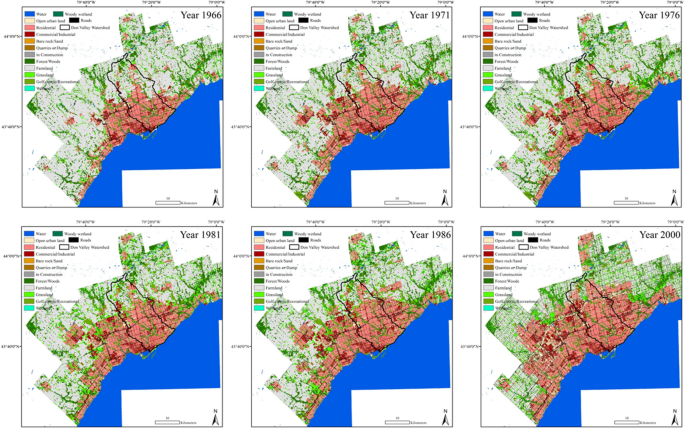
GTA Land use land cover maps from 1966 to 2000
Simulated hyetograph
An important input for the hydrologic model is a hyetograph that represents ane historical or theoretical storm event. With an input storm upshot equally the water source, the urban hydrologic model is able to model the surface runoff from the consequence. This research used a theoretical result derived from the local rainfall intensity duration frequency (IDF) bend. The local IDF curve depicts the characteristics of rainfall in an area through a serial of rainfall intensities (mm/hr) over a sure duration (hr) and with a sure return menstruum (year). This research used the IDF curve designed specifically for Toronto, Canada, available from Land Information Ontario, to generate a 24-h 100-year render storm hyetograph.
Digital Acme Model
The Toronto DEM data used in this research are obtained from Scholar GeoPortal. These provincial tiled information were published in 2006 and are composed of several source acme data in Ontario. The spatial resolution is 10 m for southern Ontario which includes the Don Valley watershed (Fig. 1). These DEM data were interpolated from the Ontario Base Map that includes both contours and spot heights. Although the DEM of city of Toronto may go through changes during the 35-year time span, we decide to use a single DEM to avoid its impact on urban flooding and proceed country apply the only changing factors in the modeling.
Soil data
The infiltration rate of soil is affected by subsurface permeability besides as surface intake rates. The Us Section of Agronomics (USDA) divided soil into four hydrologic soil groups (A, B, C, and D) according to their minimum infiltration charge per unit, which is obtained for bare soil after prolonged wetting (Cronshey 1986). Group A has low runoff potential and high infiltration rates. Grouping B has a moderate infiltration rate. Grouping C has low infiltration rates. Group D has the lowest infiltration rates and the highest runoff potential. The soil data of the study site used in this enquiry were obtained from Country Information Ontario. Unfortunately, the soil survey did not provide soil blazon for the urban surface area. Assumptions had to exist made for the large block of urban surface area based on the soil type of its surrounding rural area. In the Don Valley surface area, the surrounding soil type is mainly Group C. Thus, we assigned the unknown soil within Don Valley area as Group C. Soil Conservation Service (SCS) bend number (CN) is an empirical parameter in hydrology, developed past the USDA Natural Resources Conservation Service. The CN is used to predict direct runoff or infiltration from rainfall excess. The value of the CN mainly depends on the area's hydrologic soil group and land use types. CN has a range from 30 to 100, lower numbers indicate low runoff potential, while larger numbers are for increasing runoff potential. The USDA provides tables of CN according to hydrologic soil group and land apply (Cronshey 1986).
Methods
A coupled hydrologic and hydraulic simulation has been used in this work, where HEC-HMS describes runoff generation and HEC-RAS describes runoff routing. The HEC-HMS model considers the complete hydrologic cycle and calculates the water proceeds, loss, and transfer using hydrologic residue equations. The HEC-RAS model takes the h2o excess results from the hydrologic model as boundary weather condition and simulates the 2D water movement in the overbank areas. Effigy 3 shows the unabridged workflow of this study. The left side illustrates data drove and pre-processing. The right side outlines HEC-HMS and HEC-RAS modeling using the input data. At the offset, a simulated storm is derived from an intensity–duration–frequency (IDF) bend and input into HEC-HMS model. This input storm initiates the water movement. Depending on the DEM, soil type, and land use type of the state surface, office of rainfall goes to the groundwater water cycle (blue arrows), traveling slowly in the hydrologic system and do non contribute to flooding. The rest of the rainfall, i.e., rainfall backlog, stays on country surface and generates flash flooding or creates temporary ponds, which is the beginning procedure studied in this paper. This part applies a rainfall reduction procedure by inputting the rainfall excess derived from the HEC-HMS model equally a spatially variable rainfall for each private sub-basin in the HEC-RAS model. So, as rapid runoff of rainfall apace goes to the river organization, overbank flow from the river volition exist expected, which is the 2d process studied in this paper. This part uses the river hydrograph results from the HEC-HMS model to initiate flood model along rivers. I thing needs to be noticed is that the adding unit in HEC-HMS is sub-watershed and the calculation unit in HEC-RAS is hydraulic cell. The sizes of both sub-watershed and hydraulic cell are manually gear up past users. The size of sub-watershed depends on the complexity of terrain. A complex terrain may crave a bigger group of modest sub-watersheds to be delineated, and a uniform terrain may be well delineated with a smaller grouping of large sub-watersheds. In this study, we used ten km2 as the target sub-watersheds size considering the terrain condition in Don Valley. On the other hand, the smaller the size of hydraulic cell, in more detail the h2o menses will be calculated. However, this footstep requires a lot of computation power and is very time-consuming. Considering the resolution of DEM and land utilise, as well as our computation power, we used 20-m hydraulic jail cell in this written report. Furthermore, HEC-HMS and HEC-RAS are not specifically designed for urban area. Thus, the man-made understory drainage networks and building footprints cannot be directly included in the model. Although there are ways to consider the drainage networks and building footprints in the model (e.g., alter the infiltration rate along drainage lines, and assign high surface roughness value in edifice areas), information technology is across the scope of this research. Thus, we do not take these two urban features into consideration in this report. Since the focus of this study is to find the relation between land use and urban flooding, this simplified model will still provide instructive results.
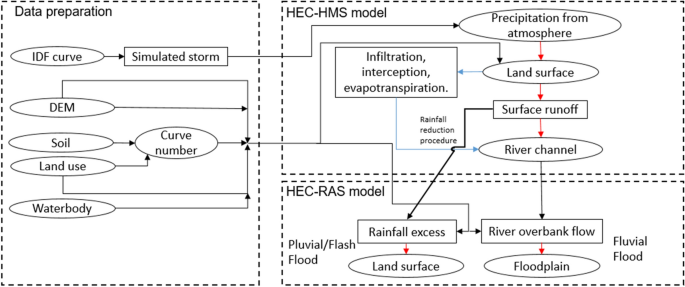
Flowchart of hydrologic and hydraulic models
Results
Results from the HEC-HMS
Sub-basin surface runoff
For the flash alluvion simulation, the watershed rainfall excess relative to surface runoff is the fundamental result from the HEC-HMS model used in the HEC-RAS model. The infiltration charge per unit in a given sub-basin was selected based on the land use type and soil type. Depending on the infiltration rate, the surface runoff amount and the time when the top belch occurs were calculated for each sub-basin. In total, 39 sub-basins were delineated based on the DEM in the study area and the rainfall backlog and surface runoff values were calculated for each of the sub-basins based on their individual infiltration rates. Four sub-basins (Fig. four-1) were selected equally examples to show how urbanization affects the surface runoff. Two of the case sub-basins, 570 and 480, are located at the upstream stop of the drainage basin, and other two sub-basins, 720 and 650, are located at the downstream end of the drainage basin. The surface runoff charge per unit is negatively closely correlated to the size of the sub-basin. The example sub-basins 480, 570, 650, and 720 cover areas of vi.8 kmtwo, 15.5 km2, 36.5 km2, and 8.iv km2, respectively.
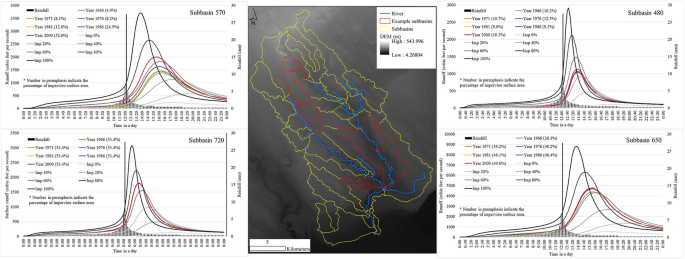
Surface runoff rate curves for four selected sub-basins nether diverse urbanization conditions
Figure 4 shows surface runoff curves from Case A and B experiments for the four case sub-basins. The colored curves are from Instance A, and the gray curves are from Case B. For all four sub-basins, the surface runoff patterns for Case B are similar, where the increases in ISA percentages create college surface runoff rates and shorten the time that takes to achieve height runoff. In regard to Case A, differences exist among the four sub-basins due to their different urbanization levels. Sub-basin 570 experiences the greatest increase (47.7%) in ISA from the twelvemonth 1966 to 2000. As a outcome, the surface runoff rates in sub-basin 570 take a noticeable increase with time and top times occur earlier from 1966 to 2000. Sub-basins 480 and 650 feel much smaller increases (eight.ane% and 11.5%, respectively) in ISA from 1966 to 2000. The surface runoff rates in sub-basins 480 and 650 exhibit detectable but express increases with fourth dimension. Sub-basin 720 is a highly urbanized area from the year of 1966 and has no detectable change in ISA per centum through from 1966 to 2000. Its surface runoff rates remain constant. The utilise of spatially detailed land utilise information in Instance A indicates that even in scenarios of pocket-size averaged ISA percentage, higher surface runoff rates are predicted than is the case for the Case B scenarios of the same averaged ISA value. For example, the surface runoff rates of sub-bowl 570 in year 2000 with a 52.6% ISA percentage are higher than surface runoff rates derived from the simulated data with a 60% ISA percentage.
River hydrograph
The river hydrograph, i.e., the rate of period at a specific time on a specific section in a river, is a key output from HEC-HMS simulation. The river hydrograph charge per unit was used in HEC-RAS modeling. Runoff in each sub-basin may reach the river to increase the hydrograph from upstream to downstream. Only locations where hydrograph changes due to boosted sources of inflow are used every bit input unsteady catamenia data in the HEC-RAS model. Six example locations (Fig. 4-2) forth the river reaches were selected to show how urbanization influences their hydrograph. The colored curves are from Example A, and the gray curves are from Example B. The hydrograph patterns in Example A indicate that urbanization leads to an increase in summit belch and shortening of the time to reach peak flow during an outcome. In the Don Valley watershed, obvious increases in ISA percentage happened between the years 1966 to 1971 (6.2%) and the years 1986 to 2000 (9.3%). In the menstruation between 1971 and 1986, only a 3% increase was establish in ISA. For the four upstream river locations (from i to iv), the later on ISA increase from the years 1986 to 2000 produced greater increase in the river flow rate than the previous ISA increase from the years 1966 to 1971. In contrast, for the two downstream river locations v and 6, the previous jump in ISA percentage produced a greater increment in the river menses charge per unit than the later one. This phenomenon may relate to the mechanism of how upstream newly developed urban land exerts pressure on the already-urbanized downstream area. Example B provides further evidence that increased ISA percentages lead to river hydrographs with college peaks. At locations one, three, 5, and half-dozen, Instance A information with a smaller average ISA pct resulted in college river hydrograph rate, compared to the Case B information with higher averaged ISA per centum merely resulted in lower river hydrograph charge per unit. This suggests that the spatial variation in urban state apply distribution is a key parameter influencing the river hydrograph (Fig. v).
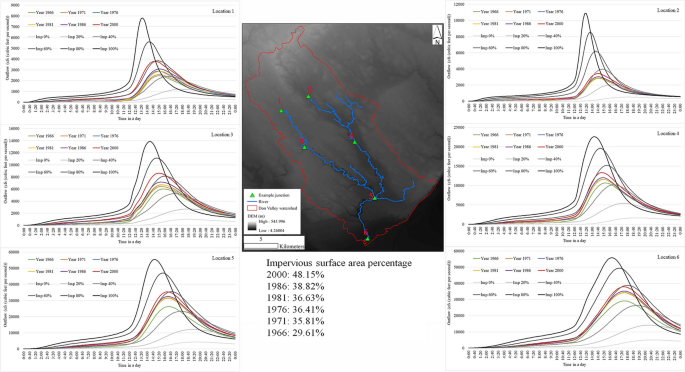
River hydrographs for half-dozen selected junctions under diverse urbanization conditions
The overall assessment of both the surface runoff and river hydrograph results between Case A and B indicates that urban land growth has significantly expediated the increment in surface runoff and river catamenia summit during a storm. However, this relation between urbanization and urban flooding is non a simple ane-to-one relation when the spatial distributions of ISA are very different (eastward.g., human-fabricated ISA cluster and uniform ISA distributions). This is why there is no meaning regression found between the ISA value and the height value of surface runoff or river hydrograph, when combining the two results from Example A and Case B.
Results from the HEC-RAS Model
Figure four-3 shows the differences in flash flood maximum water depth betwixt different simulation cases. The left figure is obtained by deducting the maximum water depth in the yr of 1966 from the maximum h2o depth in the twelvemonth of 2000, and the right figure is obtained past deducting the maximum h2o depth in the 0% ISA case from the maximum h2o depth in the 100% ISA case. Ruddy areas represent maximum h2o depth increase, and blue areas represent maximum water depth decrease from the year 1966 to 2000 and from 100 to 0% ISA percentage cases. The maps at the middle of Fig. 4-3 bear witness the spatially varied ISA percentage in the years 2000 and 1966. Comparing the two wink overflowing water difference maps, the right one shows less spatial variation, due to the uniform land use supposition in the Example B. Nevertheless, the departure map based on real land apply maps between the years of 2000 and 1966 has apparent spatial variations. Specifically, sub-basins on the northwestern upstream surface area experience more wink flood increase than those in the centre to southern downstream area, as the upper-left sub-basins experience greater increase in ISA than the middle to lower part. Although the sub-basins in the lower part of the study surface area experienced less ISA increase during the time interval, they are influenced by upstream urbanization and as well evidence increases in flash flood extent. Due to the hydrologic connectivity, the middle part of the downstream expanse (yellow circle) experience less impacts on flood peak and timing than the lake front area (green circle).
Furthermore, in the right difference map between the 100% and 0% ISA percentages cases, the decrease in flash flood extent from 100 to 0% ISA (blueish areas) is barely detectable. Nonetheless, in the real land use data example on the left, some areas experienced noticeable decreases in flash flood maximum water levels. It is possible that land utilise changes diverted water and led to decreases in maximum h2o depth in certain areas. In three black circles, the most pregnant differences between the year 1966 and 2000 were conversion from agricultural land (1966) into commercial areas (2000), reducing the country surface roughness values. This likely had the issue of assuasive flash flood waters to motility quickly through the new commercial areas (Fig. 6).
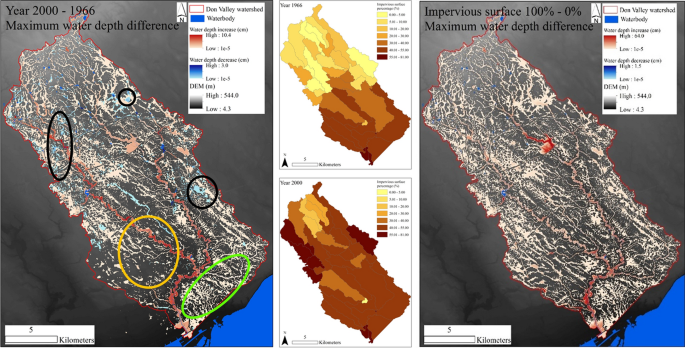
Flash alluvion deviation betwixt: left: the year of 2000 and 1966, middle: ISA percentages distribution in the yr of 2000 and 1966, and correct: the 100% and 0% ISA percentages
Effigy iv-four shows the difference in floodplain maximum water depths between different simulation cases. The left figure is obtained past deducting the maximum water depth in the twelvemonth 1966 from the maximum water depth in the year of 2000, and the right effigy is obtained by deducting the maximum water depth in the 0% ISA case from the maximum water depth in the 100% ISA case. Red areas stand for maximum water depth increase, and blue areas represent maximum h2o depth decrease from the year 1966 to 2000 or from 100 to 0% ISA percent cases. It can be noticed that floodplains feel expansion when ISA percentages grow. The floodplain departure between the twelvemonth 2000 and 1966 shows the highest water depth increase in downstream side almost the river confluence in black circle. The floodplain divergence between the 100% and 0% ISA percentages shows the highest water depth increase in the upstream side in the green circle (Fig. 7).
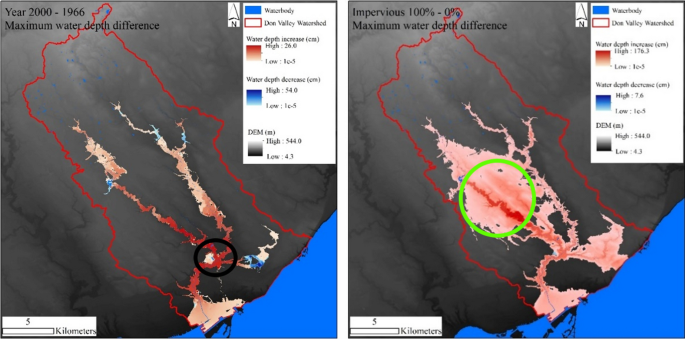
Floodplain difference between: left: the yr 2000 and 1966; right: the 100% and 0% ISA
Discussions
Results from HEC-HMS
Near-linear relations between the surface runoff rate and impervious surface percentage can be establish for the four selected sub-basins in Sect four.1.i Sub-bowl surface runoff for both Instance A and Example B scenarios. The slope and R-squared values of the linear regressions are listed in Tabular array 1. The high R-squared values suggest expert correlation between these ii variables. The slopes of the linear regressions represent the increment in surface runoff rate by each ane% increase in ISA percent. It can be seen that the Instance B results accept much higher slopes than in Instance A. The reason for the college normalized slopes in the Case B may lie in the assumption of compatible land utilise.
Virtually-linear relations can be plant for the selected case river locations in 4.1.2 River hydrograph for both Example A and Instance B. The slope and R-squared values of the linear regressions are listed in Table two. The loftier R-squared values advise good correlation between these two variables. The slopes of the linear regressions represent the increase in river period charge per unit past each i% increase in ISA percentage. The downstream locations had more than river flow rate increment than the upstream locations. Among the selected locations, the virtually downstream point (Location half dozen) experiences a half-dozen to seven times higher river flow rate increase compared to the most upstream signal (Location 1). It is noted that the Example B results exhibit higher normalized slopes than the Instance A.
It is an interesting finding that we find stiff linear regression between ISA % and the summit value of surface runoff or river hydrograph when results from Instance A and Case B are studied separately, while we observe no significant regression between these features when results from Case A and Case B are studied together. This may because that although surface runoff/river hydrograph is governed past both ISA percentage and spatial distribution of state apply, but 1 of them, which from our results seems to be ISA percentage, has more impact than the other. Then when the change in ISA percentage is very big and the spatial distribution of country use is somewhat similar, the impact of the spatial distribution of land utilize is insignificant. There may exist thresholds for the 2 factors to exert significant impact.
Results from HEC-RAS
Although the HEC-RAS model calculates the water depths and velocities during the entire rainfall event, only the maximum h2o depth maps of wink flooding and floodplain are discussed here, since this result is straightforward for comparing. Tabular array 3 summarizes key attributes of the flash inundation and floodplain maps. For the flash overflowing maps covering 1966 to 2000, the flood-influenced area increased by 3% and the maximum depth increased past 13 centimeters (cm). For the floodplain maps, from 1966 to 2000, the overflowing-influenced expanse increased by 10% and the maximum depth increased past vi cm. In the flash flood maps, 100% ISA per centum case doubles the influenced areas and maximum depths from the 0% ISA per centum instance. In the floodplain maps, the 100% ISA percentage case has flood-influenced areas that are over 5 times larger than the flood-influenced areas from the 0% ISA percentage instance. In terms of similar average ISA percentages, the Case A data appear to outcome in much college surface runoff compared to the Example B data. The spatially varied state utilise distribution tends to aggregate the surface runoff compared to spatially uniform land apply. This may chronicle to the hydrologic connectivity found in different land use patterns. In the flash overflowing maps, the Case A results show large flood-influenced areas from 1966 whose ISA percent is only 29.61%. However, the flash flood maps from the Case B show smaller flood-influenced areas than the results from the Case A, at similar ISA percentages. This discontinuity betwixt the Case A and B is not severe in the floodplain maps. This fact indicates that the country use distribution greatly affects the extent of the flash overflowing and has less issue on the size of floodplain extent.
Conclusions
This research provides experiments on the impact of urbanization on urban flooding, which assists the agreement of this specific factor in urban flooding. Six land use maps from dissimilar years (1966, 1971, 1976, 1981, 1986, and 2000) and 6 simulated atmospheric condition (0%, 20%, twoscore%, lx%, 80% and 100% ISA percentages) were input into the hydrologic/hydraulic models, in order to generate both flash flood and floodplain maps. Positive linear relations are establish between the surface runoff charge per unit/river outflow rate and ISA percentage in experiments. Specifically, urbanization leads to the increase in peak belch and shortens the time earlier the peak arrives during an event. The influenced areas by the flash flood and floodplain expand due to continuous urbanization. The downstream areas exhibited college flood depth increases and larger flood extent increases than the upstream areas due to urbanization in the contributing areas. With the aforementioned average ISA percentage, the spatially varied land apply may aggregate the wink flood condition compared to spatially compatible land use. This fact may be due to the different hydrologic connectivity in the two groups of cases. The flash alluvion and floodplain results from the simplified hydrologic/hydraulic models share some patterns constitute in the real flooding events likewise every bit results from other flood models. The issue from this research proves that urbanization has worsened urban flooding to a great extent. With the cumulated damage from continuous urbanization, the severity of urban flooding is expected to increment. In the stop, it is worth noting that such promising results likewise come with affordable ciphering times. Every bit detailed flood modeling may have days to run in big areas, the simplified models used in this research simply takes as little as four hours for the flash flood modeling and twenty min for the floodplain mapping for an area of 367 km2.
Notes
-
Impervious surface are mainly artificial structures that are covered by bulletproof materials such as asphalt, concrete, brick, and stone.
-
Hydraulic roughness is the mensurate of the amount of frictional resistance water experiences when passing over state and channel features, which closely relates to state use types.
References
-
Al-Ghamdi KA, Elzahrany RA, Mirza MN, Dawod GM (2012) Impacts of urban growth on flood hazards in Makkah City, Saudi Arabia. Int J Water Resour Environ Eng 4:23–34
-
Anderson DG (1970) Effects of urban development on floods in northern Virginia. US Government Printing Part
-
Apel H, Trepat OM, Hung NN, Merz B, Dung NV (2016) Combined fluvial and pluvial urban flood hazard analysis: concept development and application to Can Tho city, Mekong Delta, Vietnam. Nat Hazards Earth Syst Sci xvi:941–961
-
Armenakis C, Nirupama N (2014) Flood risk mapping for the urban center of Toronto. Proc Econ Finance xviii:320–326
-
Banasik Grand, Pham N (2010) Modelling of the effects of state use changes on inundation hydrograph in a pocket-sized catchment of the Płaskowicka, southern part of Warsaw, Poland. Ann Warsaw Univ Life SciSGGW Land Reclam 42:229–240
-
Berezowski T, Chormański J, Batelaan O, Canters F, Van de Voorde T (2012) Impact of remotely sensed land-cover proportions on urban runoff prediction. Int J Appl Earth Obs Geoinf 16:54–65
-
Booth DB (1991) Urbanization and the natural drainage system–impacts, solutions, and prognoses
-
Bronstert A, Bárdossy A, Bismuth C, Buiteveld H, Disse 1000, Engel H, Fritsch U, Hundecha Y, Lammersen R, Niehoff D (2007) Multi-scale modelling of land-employ change and river training effects on floods in the Rhine basin. River Res Appl 23:1102–1125
-
Chen As, Djordjević S, Leandro J, Savić D (2010) An analysis of the combined consequences of pluvial and fluvial flooding. Water Sci Technol 62:1491–1498
-
Cronshey R (1986) Urban hydrology for small-scale watersheds. US Dept. of Agriculture, Soil Conservation Service, Engineering Partitioning
-
Dingman SL (2015) Physical hydrology. Waveland Press
-
Espey WH Jr, Morgan CW, Masch FD (1966) Study of some effects of urbanization on storm runoff from a small watershed. Texas H2o Evolution Board
-
Hashemyan F, Khaleghi M, Kamyar M (2015) Combination of HEC-HMS and HEC-RAS models in GIS in gild to Simulate Flood (Case written report: khoshke Rudan river in Fars province, Islamic republic of iran). Res J Recent Sci iv:122–127
-
Hollis 1000 (1974) The upshot of urbanization on floods in the Canon'southward Brook, Harlow, Essex. In: Fluvial processes in instrumented watersheds. Found of British Geographers, London, United kingdom, pp 123–139
-
Hollis G (1975) The event of urbanization on floods of different recurrence interval. Water Resour Res 11:431–435
-
Huang Q, Wang J, Li M, Fei M, Dong J (2017) Modeling the influence of urbanization on urban pluvial flooding: a scenario-based case study in Shanghai, China. Nat Hazards 87:1035–1055
-
Kellershohn D (2016) Reducing alluvion adventure in Toronto. Plant for Catastrophoc Loss Reduction Forum
-
Khaghan AAM, Mojaradi B (2016) The Integrate of HEC-HMS and HEC-RAS Models in GIS Integration Models to Simulate Flood (Example Study: the Area of Karaj). Curr World Environ 11:1
-
Kinosita T, Sonda T (1971) Change of runoff due to urbanization. In Publication of: Airport Forum.
-
Martens L (1966) Overflowing inundation and effects of urbanization in metropolitan Charlotte [Due north Carolina]: The states Geol. Survey Open-File Rept 54
-
Moscrip AL, Montgomery DR (1997) Urbanization, alluvion frequency, and Salmon abundance in Puget lowland streams 1. JAWRA J Am Water Resour Every bit 33:1289–1297
-
Nirupama N, Armenakis C, Montpetit One thousand (2014) Is flooding in Toronto a concern? Nat Hazards 72:1259–1264
-
Patra JP, Kumar R, Mani P (2016) Combined fluvial and pluvial overflowing inundation modelling for a project site. Proc Technol 24:93–100
-
Prosdocimi I, Kjeldsen T, Miller J (2015) Detection and attribution of urbanization issue on flood extremes using nonstationary flood-frequency models. H2o Resour Res 51:4244–4262
-
Rossman LA (2010) Storm water management model user's transmission, version 5.0. National Chance Management Enquiry Laboratory, Office of Research and Development, US Environmental Protection Agency Cincinnati
-
Verbeiren B, Van de Voorde T, Canters F, Binard 1000, Cornet Y, Batelaan O (2013) Assessing urbanisation effects on rainfall-runoff using a remote sensing supported modelling strategy. Int J Appl World Obs Geoinf 21:92–102
-
Villarini G, Smith JA, Serinaldi F, Bales J, Bates PD, Krajewski WF (2009) Flood frequency analysis for nonstationary annual peak records in an urban drainage bowl. Adv Water Resour 32:1255–1266
-
Water One thousand (2010) MUSIC Guidelines; Recommended input parameters and modelling approaches for MUSIC users. State Regime of Victoria, Melbourne
-
Yin J, Yu D, Yin Z, Wang J, Xu S (2015) Modelling the anthropogenic impacts on fluvial overflowing risks in a littoral mega-metropolis: a scenario-based instance report in Shanghai, China. Landscape Urban Program 136:144–155
-
Yu D, Lane SN (2006a) Urban fluvial alluvion modelling using a ii-dimensional improvidence-moving ridge treatment, role 1: mesh resolution furnishings. Hydrol Procedure Int J 20:1541–1565
-
Yu D, Lane SN (2006b) Urban fluvial flood modelling using a two-dimensional diffusion-moving ridge treatment, part ii: development of a sub-grid-scale treatment. Hydrol Procedure Int J twenty:1567–1583
-
Zhang Y, Guindon B, Sun One thousand (2010) Measuring Canadian urban expansion and impacts on work-related travel distance: 1966–2001. J Land Use Sci v:217–235
-
Zhang Y, Guindon B, Sun K (2015) Spatial-temporal-thematic assimilation of Landsat-based and archived historical data for measuring urbanization processes. J Land Use Sci x:369–387
-
Zhao G, Gao H, Cuo L (2016) Furnishings of urbanization and climate change on elevation flows over the San Antonio River Basin, Texas. J Hydrometeorol 17:2371–2389
Acknowledgement
This research was supported by the Public Safety Canada through the Water Programme of Canada Center of Mapping and Earth Ascertainment, Natural Resources Canada.
Funding
This research was supported by the Public Safety Canada through the Water Program of Canada Eye of Mapping and Earth Observation, Natural Resources Canada.
Writer data
Affiliations
Corresponding author
Ethics declarations
Conflict of interest
In that location is no conflict of interest that we know of for this work.
Boosted information
Publisher'southward Note
Springer Nature remains neutral with regard to jurisdictional claims in published maps and institutional affiliations.
Rights and permissions
Open Admission This article is licensed under a Creative Commons Attribution 4.0 International License, which permits use, sharing, accommodation, distribution and reproduction in whatsoever medium or format, as long as y'all give advisable credit to the original author(s) and the source, provide a link to the Creative Eatables licence, and bespeak if changes were made. The images or other tertiary party material in this article are included in the article's Creative Commons licence, unless indicated otherwise in a credit line to the material. If material is not included in the article's Creative Commons licence and your intended use is not permitted by statutory regulation or exceeds the permitted use, you will need to obtain permission directly from the copyright holder. To view a re-create of this licence, visit http://creativecommons.org/licenses/past/iv.0/.
Reprints and Permissions
About this commodity
Cite this article
Feng, B., Zhang, Y. & Bourke, R. Urbanization impacts on flood risks based on urban growth data and coupled alluvion models. Nat Hazards 106, 613–627 (2021). https://doi.org/10.1007/s11069-020-04480-0
-
Received:
-
Accepted:
-
Published:
-
Result Date:
-
DOI : https://doi.org/x.1007/s11069-020-04480-0
Keywords
- Urbanization
- Flash overflowing
- Floodplain
- Hydrologic model
- And hydraulic model
Source: https://link.springer.com/article/10.1007/s11069-020-04480-0
0 Response to "what effect does urban development have on flooding compared to rural areas?"
Post a Comment